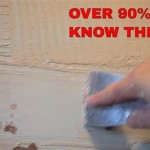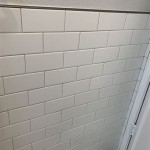How to Clean Dirty Bathroom Floor Tile Grout
Dirty grout is a common issue in bathrooms, significantly impacting the overall cleanliness and aesthetic of the space. Grout, being porous, readily absorbs dirt, grime, mold, and mildew, leading to discoloration and an unhygienic environment. Regular cleaning is essential to maintain the appearance and prevent the buildup of stubborn stains. This article details various methods for effectively cleaning dirty bathroom floor tile grout.
Understanding Grout and Its Susceptibility to Dirt
Grout is typically composed of cement, sand, and water, creating a porous material used to fill the gaps between tiles. This porosity allows liquids and particulate matter to penetrate the surface, making it highly susceptible to staining. The bathroom environment, characterized by humidity and moisture, further exacerbates the problem by promoting the growth of mold and mildew within the grout lines. Understanding these inherent properties of grout is crucial for selecting the appropriate cleaning methods and preventative measures.
Furthermore, the color of the grout plays a role in how easily dirt and stains are noticeable. Lighter-colored grout, such as white or beige, will show dirt and discoloration much more readily than darker shades. Therefore, regular cleaning is even more important for lighter grout to maintain its original appearance. Ignoring regular cleaning allows stains to set deeper into the grout, making them more difficult to remove over time.
The type of grout used can also affect its susceptibility to dirt. Epoxy grouts are less porous than cement-based grouts and are thus more resistant to staining and mildew growth. However, epoxy grouts are typically more expensive and can be more difficult to install. Regardless of the type of grout used, regular maintenance and cleaning are essential for preserving its condition and appearance.
Effective Cleaning Methods: Everyday and Deep Cleaning Approaches
Maintaining clean grout requires a combination of everyday cleaning and periodic deep cleaning. Everyday cleaning involves regularly wiping down the bathroom floor to remove loose dirt and spills. This can be accomplished with a damp mop or sponge using a mild detergent solution. Addressing spills promptly prevents them from soaking into the grout and causing permanent stains.
Deep cleaning, on the other hand, involves more intensive methods to remove embedded dirt, mold, and mildew. Several effective deep cleaning solutions and techniques can be employed, depending on the severity of the staining and the type of grout used. These methods range from using readily available household ingredients to specialized grout cleaning products.
Before initiating any cleaning method, it's essential to test the chosen solution in an inconspicuous area to ensure it does not damage the tile or grout. This precautionary step helps prevent discoloration or etching of the surfaces. Adequate ventilation is also crucial when using cleaning products, especially those with strong chemical odors.
Detailed Cleaning Solutions and Techniques
Several cleaning solutions and techniques can be employed to effectively clean dirty bathroom floor tile grout. The method chosen will depend on the severity of the staining and the desired level of cleaning. Here are some common and effective techniques:
1. Baking Soda and Vinegar Paste: This is a natural and effective cleaning solution for mildly stained grout. Combine baking soda and white vinegar to form a paste. Apply the paste to the grout lines and let it sit for 15-20 minutes. Scrub the grout with a stiff-bristled brush (a toothbrush works well for small areas) and rinse thoroughly with water. The fizzing action of the vinegar and baking soda helps to lift dirt and grime from the grout pores.
2. Hydrogen Peroxide: Hydrogen peroxide is a mild bleaching agent that can help remove stains and kill mold and mildew. Apply a 3% hydrogen peroxide solution directly to the grout lines. Allow it to sit for 10-15 minutes, then scrub with a brush and rinse with water. This method is particularly effective for lightening stained grout and removing mildew.
3. Commercial Grout Cleaners: Numerous commercial grout cleaners are available on the market, ranging from mild to heavy-duty formulations. When selecting a commercial cleaner, it is crucial to read the label carefully and follow the manufacturer's instructions. Some commercial cleaners contain harsh chemicals, such as bleach or ammonia, which may irritate skin and respiratory systems. Always wear gloves and ensure adequate ventilation when using these products. Apply the cleaner to the grout lines, allow it to sit for the recommended time, scrub with a brush, and rinse thoroughly with water.
4. Steam Cleaning: Steam cleaning is a non-chemical method for cleaning grout. The high-temperature steam loosens dirt and grime, which can then be wiped away with a cloth or brush. Steam cleaners can be particularly effective for removing stubborn stains and killing mold and mildew without the use of harsh chemicals. Direct the steam nozzle along the grout lines, then wipe away the loosened dirt with a clean cloth.
5. Oxygen Bleach: Unlike chlorine bleach, oxygen bleach is a gentler alternative that can effectively remove stains without damaging the grout or releasing harmful fumes. Mix oxygen bleach powder with water according to the manufacturer's instructions to create a cleaning solution. Apply the solution to the grout lines, let it sit for several hours (or even overnight), and then scrub with a brush and rinse with water. Oxygen bleach is particularly effective for removing organic stains, such as those caused by mold and mildew.
6. Borax: Borax is a natural mineral with cleaning and disinfectant properties. Mix borax with water to form a paste. Apply the paste to the grout lines, let it sit for 15-20 minutes, scrub with a brush, and rinse with water. Borax is effective for removing dirt, grime, and mildew.
When scrubbing grout, using a grout brush with stiff bristles is essential for effective cleaning. An old toothbrush can be used for smaller areas or tight corners. Avoid using metal brushes or abrasive scrub pads, as they can damage the grout and tile surfaces.
Preventative Measures to Minimize Grout Dirt Accumulation
Preventing grout from becoming dirty in the first place is the most effective way to maintain a clean bathroom. Implementing preventative measures can significantly reduce the need for frequent deep cleaning. These measures include:
1. Regular Cleaning: As mentioned previously, wiping down the bathroom floor regularly with a damp mop or sponge and a mild detergent solution removes loose dirt and spills before they have a chance to penetrate the grout. Aim to clean the floor at least once a week, or more frequently in high-traffic areas.
2. Proper Ventilation: Adequate ventilation in the bathroom is crucial for reducing humidity and preventing the growth of mold and mildew. Ensure the bathroom is well-ventilated by opening windows or using an exhaust fan during and after showers or baths. This helps remove moisture from the air, reducing the likelihood of mold and mildew growth in the grout.
3. Sealing the Grout: Applying a grout sealer creates a protective barrier that prevents water and dirt from penetrating the grout pores. Grout sealers are available in various formulations, including penetrating sealers and surface sealers. Penentrating sealers are absorbed into the grout, while surface sealers form a film on the surface. Apply the sealer according to the manufacturer's instructions, typically after cleaning the grout thoroughly and allowing it to dry completely. Reapply the sealer periodically, as recommended by the manufacturer, to maintain its effectiveness.
4. Using Bath Mats and Rugs: Placing bath mats and rugs in strategic locations, such as in front of the shower or bathtub and near the sink, can help absorb water and prevent it from splashing onto the floor and grout. Choose mats and rugs that are absorbent and easily washable.
5. Addressing Leaks Promptly: Repairing any leaks promptly, whether from faucets, pipes, or showerheads, is essential for preventing water damage and mold growth. Leaks contribute to excessive moisture in the bathroom, creating a favorable environment for mold and mildew to thrive. Addressing leaks immediately can prevent costly repairs and health hazards.
6. Choosing the Right Cleaning Products: Avoid using harsh chemicals or abrasive cleaners that can damage the grout. Opt for gentle, pH-neutral cleaners specifically designed for tile and grout. Avoid using acidic cleaners, such as vinegar, on natural stone tiles, as they can etch the surface. Always test the cleaner in an inconspicuous area before applying it to the entire floor.
By implementing these preventative measures, homeowners can significantly reduce the amount of dirt and grime that accumulates in bathroom floor tile grout, making regular cleaning easier and more effective. A proactive approach to grout maintenance is crucial for preserving the appearance and hygiene of the bathroom.

How To Clean Grout Tile Cleaning Tips Simply Spotless

How To Clean Grout Tips For Natural Stone Flooring Granite Gold

How To Clean Bathroom Tile And Grout Reviews By Wirecutter

How To Clean Grout Two Ingredient Diy Cleaner Lemons Lavender Laundry

How To Clean Tile Grout Floor Cleaning Dirty Whitened

How I Clean Dirty Tile Grout Elbow Grease Water Barkeepers Friend Best

How To Clean Tile Floors

The Ultimate Guide To Cleaning Grout 10 Diy Tile Cleaners Tested Bren Did

The Best Tile And Grout Cleaners For Every Surface Chet S Cleaning

7 Proven Ways To Clean Shower Tile Works Every Time
Related Posts








